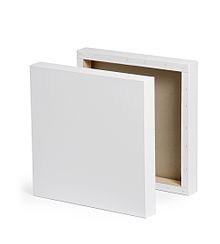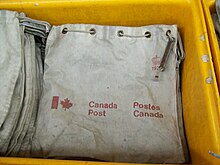Canvas


Canvas is an extremely durable
and for other items for which sturdiness is required, as well as in such fashion objects as handbags, electronic device cases, and shoes. It is popularly used by artists as a painting surface, typically stretched across a wooden frame.Modern canvas is usually made of cotton or linen, or sometimes polyvinyl chloride (PVC), although historically it was made from hemp. It differs from other heavy cotton fabrics, such as denim, in being plain weave rather than twill weave. Canvas comes in two basic types: plain and duck. The threads in duck canvas are more tightly woven. The term duck comes from the Dutch word for cloth, doek. In the United States, canvas is classified in two ways: by weight (ounces per square yard) and by a graded number system. The numbers run in reverse of the weight so a number 10 canvas is lighter than number 4.
The word "canvas" is derived from the 13th century Anglo-French canevaz and the Old French canevas. Both may be derivatives of the Vulgar Latin cannapaceus for "made of hemp", originating from the Greek κάνναβις (cannabis).[2][3]
For painting

Canvas has become the most common
Panel painting remained more common until the 16th century in Italy and the 17th century in Northern Europe. Mantegna and Venetian artists were among those leading the change; Venetian sail canvas was readily available and regarded as the best quality.

Canvas is usually stretched across a wooden frame called a
Many artists have painted onto unprimed canvas, such as
When I first started doing the stain paintings, I left large areas of canvas unpainted, I think, because the canvas itself acted as forcefully and as positively as paint or line or color. In other words, the very ground was part of the medium, so that instead of thinking of it as background or negative space or an empty spot, that area did not need paint because it had paint next to it. The thing was to decide where to leave it and where to fill it and where to say this doesn't need another line or another pail of colors. It's saying it in space.[7]

Early canvas was made of linen, a sturdy brownish fabric of considerable strength. Linen is particularly suitable for the use of oil paint. In the early 20th century, cotton canvas, often referred to as "cotton duck", came into use. Linen is composed of higher quality material, and remains popular with many professional artists, especially those who work with oil paint. Cotton duck, which stretches more fully and has an even, mechanical weave, offers a more economical alternative. The advent of acrylic paint has greatly increased the popularity and use of cotton duck canvas. Linen and cotton derive from two entirely different plants, the flax plant and the cotton plant, respectively.
Gessoed canvases on stretchers are also available. They are available in a variety of weights: light-weight is about 4 oz/sq yd (140 g/m2) or 5 oz/sq yd (170 g/m2); medium-weight is about 7 oz/sq yd (240 g/m2) or 8 oz/sq yd (270 g/m2); heavy-weight is about 10 oz/sq yd (340 g/m2) or 12 oz/sq yd (410 g/m2). They are prepared with two or three coats of gesso and are ready for use straight away. Artists desiring greater control of their painting surface may add a coat or two of their preferred gesso. Professional artists who wish to work on canvas may prepare their own canvas in the traditional manner.
One of the most outstanding differences between modern painting techniques and those of the Flemish and Dutch Masters is in the preparation of the canvas. "Modern" techniques take advantage of both the canvas texture as well as those of the paint itself. Renaissance masters took extreme measures to ensure that none of the texture of the canvas came through. This required a painstaking, months-long process of layering the raw canvas with (usually) lead-white paint, then polishing the surface, and then repeating.[8] The final product had little resemblance to fabric, but instead had a glossy, enamel-like finish.
With a properly prepared canvas, the painter will find that each subsequent layer of color glides on in a "buttery" manner, and that with the proper consistency of application (
Canvas can also be printed on using
For embroidery
Canvas is a popular base fabric for embroidery such as cross-stitch and Berlin wool work.[9] Some specific types of embroidery canvases are Aida cloth (also called Java canvas[10]), Penelope canvas, Chess canvas, and Binca canvas.[11][12][13] Plastic canvas is a stiffer form of Binca canvas.[14]
As a compound agent


From the 13th century onwards, canvas was used as a covering layer on
Splined canvas, stretched canvas and canvas boards
Splined canvases differ from traditional side-stapled canvas in that canvas is attached with a spline at the rear of the frame. This allows the artist to incorporate painted edges into the artwork itself without staples at the sides, and the artwork can be displayed without a frame. Splined canvas can be restretched by adjusting the spline.
Stapled canvases stay stretched tighter over a longer period of time, but are more difficult to re-stretch when the need arises.
Canvas boards are made of canvas stretched over and glued to a
Types
- Dyed canvas
- Fire-proof canvas
- Printed canvas
- Stripe canvas
- Water-resistant canvas
- Waterproof canvas
- Waxed canvas
- Rolled canvas
Products
- Wood-and-canvas canoes (see photo of canvas being stretched on a canoe)
- Bags, including coated canvas (e.g. Goyard)
- Non-disintegrating ammunition belts, which have evenly spaced pockets to allow the belt to be mechanically fed into the machine gun.
- Covers and tarpaulins
- )
- Tents
- Swags
- Martial arts uniforms (e.g. Tokaido, Shureido, Judogi)
- Canvas Prints
- Wrestling canvas, used in WWE and other Sports Entertainment promotions.
- Vests, often fishing, hunting, tactical/military
- Coats
- Jackets
- Vehicle seat covers
See also
References
- Gordon, Dillian, National Gallery Catalogues (new series): The Fifteenth Century Italian Paintings, Volume 1, 2003, ISBN 1857092937
- ^ "National Museum (Muzeum Narodowe)". www.warsawtour.pl. Archived from the original on 7 October 2013. Retrieved 20 October 2013.
the largest Polish painting "Battle of Grunwald" by Jan Matejko (426 x 987 cm).
- ^ "The Online Etymology Dictionary". Etymonline.com. Retrieved 2012-05-05.
- ^ "Oxford Dictionaries". Oxford University Press. Archived from the original on March 13, 2013. Retrieved 2014-03-01.
- ^ Gordon, xiii
- ^ Gordon, xv
- ^ "Jackson Pollock – A Life". Theblurb.com.au. 2002-10-04. Archived from the original on 2012-03-21. Retrieved 2012-05-05.
- ISBN 0-89659-418-1
- ^ "Classical Oil Painting Technique". Cartage.org.lb. Archived from the original on 2012-03-01. Retrieved 2012-05-05.
- ISBN 978-0955605574.
- ISBN 9780486228006.
Aida Canvas. — This material, introduced under the French name Toile Colbert, is a description of linen cloth. It is also called " Aida Cloth," and Java Canvas ( which see), as well as " Fancy Oatmeal."
- ^ White, A. V. Primary Embroidery Stitches and Designs. Taylor & Francis.
- ^ Bendure, Zelma & Gladys (1946). America's fabrics: origin and history, manufacture, characteristics and uses. Macmillan Company. p. 616.
- ISBN 0486426092.
- ISBN 978-1905780334.
